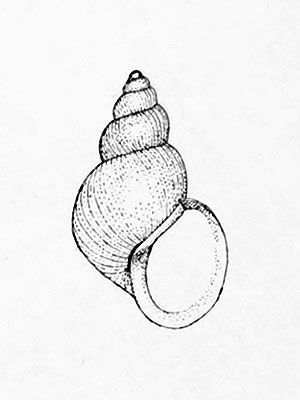White-spotted Long-horned Caddisfly (Ceraclea albosticta)
The White-spotted Long-horned Caddisfly was described in 1861; the species was apparently quite widespread, thus it is strange that its name appears in listings of extinct species.
It is mentioned here for the sake of completeness until I will be able to get further information.
*********************
edited: 01.11.2020
Tag Archives: New York
Lottia alveus ssp. alveus (Conrad)
The Eelgrass Limpet aka. Bowl Limpet was described in 1831; it lived in the western Atlantic Ocean and was once quite common and widespread, having been found from Labrador in Canada as far south as New York, USA.
The species was adapted to inhabit the leaf blades of Eelgrass (Zostera marina L.); large parts of the eelgrass colonies along the western Atlantic coastlines suddenly died in the early 1930s by a disease caused by a slime mold. The eelgrass survived only because some populations inhabited brackish water into which the mold could not spread; the limpet, however, was not able to adapt to brackish water and thus the whole species died out due to the complete loss of its only habitat and host.
The Eelgrass Limpet was last seen in 1929 but was declared extinct only in 2000; another subspecies, the Pacific Eelgrass Limpet (Lottia alveus ssp. parallella (Dall)) (see photo), still survives in the waters of the northern Pacific Ocean.
*********************

Pacific Eelgrass Limpet (Lottia alveus ssp. parallella)
Photo: nwisland
https://www.inaturalist.org/people/nwisland
https://creativecommons.org/licenses/by-nc/4.0/
*********************
edited: 17.08.2022
Fossaria cyclostoma Walker
Bugle Fossaria (Fossaria cyclostoma)
This freshwater snail is known only from several relict populations from disjunct, in other words disconnected areas in the US-American states of Michigan and New York.
The shell reached a height of about 0,75 cm.
The species is now considered extinct.
*********************

(not in copyright)
*********************
edited: 07.11.2020
Conuropsis carolinensis ssp. carolinensis (L.)
Carolina Parakeet (Conuropsis carolinensis ssp. carolinensis)
The Carolina Parakeet was one of only two parrot species that are truly native to the USA (the other one is the Thick-billed Parakeet (Rhynchopsitta pachyrhyncha (Swainson)) which, however, is now extinct there and only survives in northern Mexico).
The Chickasaw people named the bird ‘kelinky’, the Seminoles again named it ‘pot pot chee’ or ‘puzzi la née’.
The species had a very wide distributional area in the southern USA, where it inhabited old-growth wetland forests along rivers and swamps. The parakeets had a preference for the seeds of the Rough Cocklebur (Xanthium strumarium L.) (see lso depiction below), a plant that contains toxic glucoside, making the flesh of the birds poisonous to predators (the American naturalist and painter John J. Audubon noted that cats apparently died from eating them).
***
The Carolina Parakeet was considered a crop pest and birds were shot by the thousands. Some also ended in the feather trade, in which it apparently was especially popular to dye the originally very colorful birds completely black – such blackened specimens are still kept in several museums.
The last known Carolina Parakeet, a male named Incas, died in the Zoo of Cincinnati, Ohio at February 21, 1918. Yet, in the wild the species apparently survived for several years longer, this can be assumed from eggs that are kept in a museum and that had been collected in Florida in the year 1927.
***
The Carolina Parakeet wasn’t particularly popular in the aviculture, especially because of its loud, harsh voice, however, the ornithologist Hans Freiherr von Berlepsch at the end of he 19th century kept a free-flying population in Germany which, being well-adapted to the European climate was thriving very well. This little population, that could have been the lifeline for the whole species, however, was shot by the innkeeper of a little pub in a neighboring village within only two days.
*********************
edited: 20.01.2020
